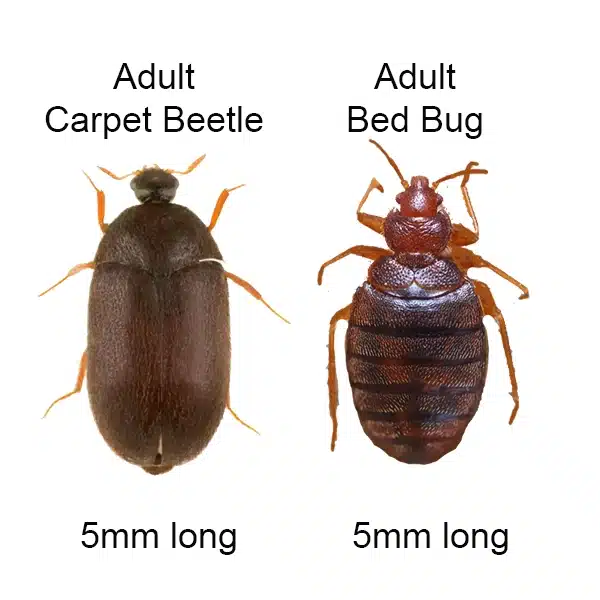
In the article
There are a lot of bugs that look like bed bugs. Identifying bed bugs can be a challenging task, especially since several other bugs resemble them closely. Misidentifying a pest problem can lead to ineffective treatments, so it’s essential to distinguish bed bugs from their look-alikes.
Here’s a detailed guide on bugs commonly mistaken for bed bugs, including features that make them similar and those that set them apart.
1. Bat Bugs
- Similar Feature: Bat bugs look almost identical to bed bugs, sharing the same size and shape.
- Different Feature: Bat bugs have longer fringe hairs on the pronotum (the area behind the head).
- Habitat: Typically found where bats roost, such as attics and behind walls. If bats are removed, bat bugs may move into living spaces in search of new hosts.
- Behaviour: They feed on bat blood but can bite humans if necessary.
- Bite: Yes
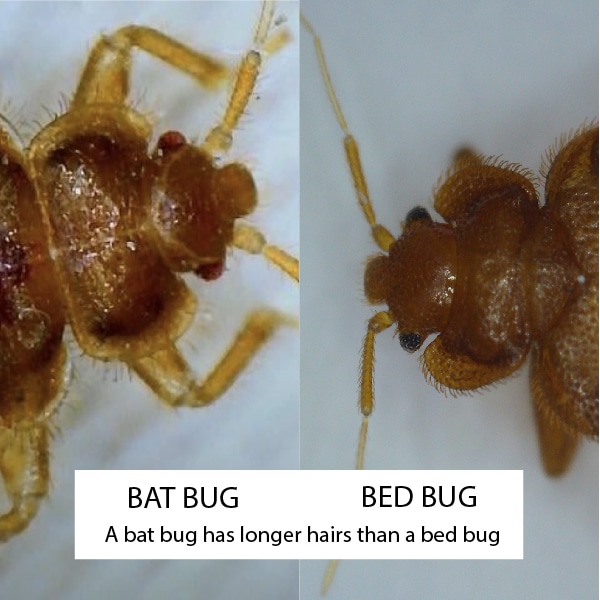
Bat Bug vs Bed Bug
2. Book Lice
- Similar Feature: Booklice can be found indoors, similar to bed bugs.
- Different Feature: Booklice are much smaller (1-2 mm) with a softer body and a pale brown or creamy yellow colour.
- Habitat: Thrive in high humidity environments, found in books, under wallpaper, and mouldy areas.
- Behaviour: Feed on mould, mildew, and starchy materials, not on blood.
- Bite: No. But the presence of book lice can cause allergic reactions in some individuals.
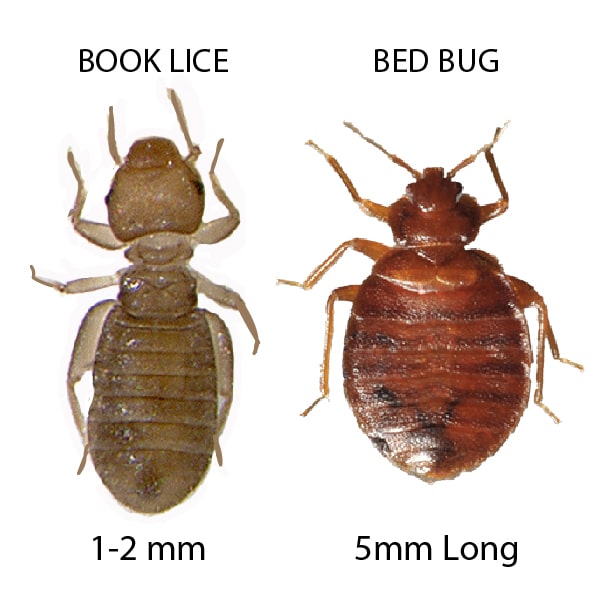
Bed Bug vs Book Lice
3. Spider Beetles
- Similar Feature: Spider beetles have a round body shape and a size similar to bed bugs.
- Different Feature: They have a hard, shiny exoskeleton and are typically found in stored food products.
- Habitat: Found in grains, dried fruits, and animal products, as well as dark, undisturbed places like attics and basements.
- Behaviour: They are scavengers feeding on various organic materials.
- Bite: Yes
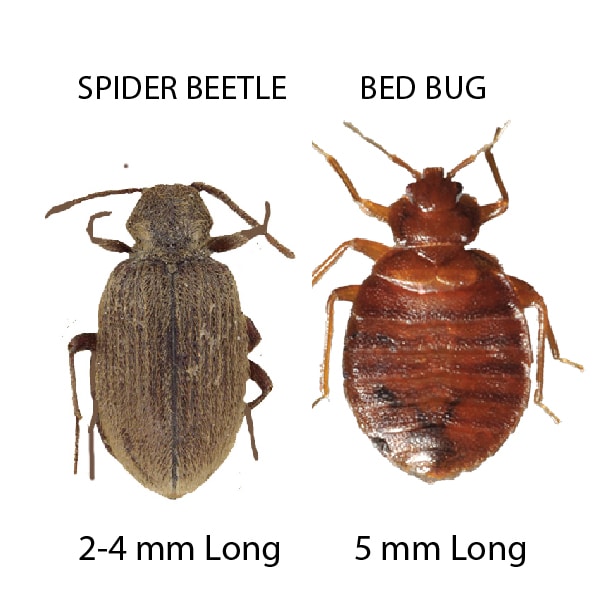
Spider Beetle vs Bed Bug
4. Carpet Beetles
- Similar Feature: Small, round body that can be mistaken for bed bugs.
- Different Feature: Carpet beetles are often multicoloured with scales and feed on natural fibres.
- Habitat: Found in carpets, fabrics, and stored food, attracted to natural fibres like wool and silk.
- Behaviour: Larvae (known as “woolly bears”) feed on animal products, while adults feed on pollen and nectar.
- Bite: No. But the presence of book lice can cause allergic reactions in some individuals.
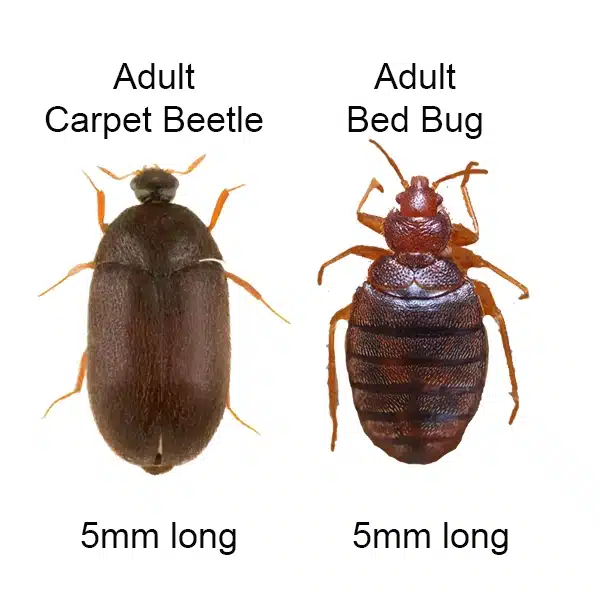
5. Cockroach Nymphs
- Similar: Feature: Similar body shape and size to bed bugs.
- Different: Feature: More cylindrical body and long antennae, plus they are scavengers rather than blood feeders.
- Habitat: Found in kitchens, bathrooms, and areas with access to food and moisture.
- Behaviour: Cockroaches are omnivores feeding on a variety of organic matter.
- Bite: Cockroaches are not likely to bite living humans, except in cases of extreme infestations.
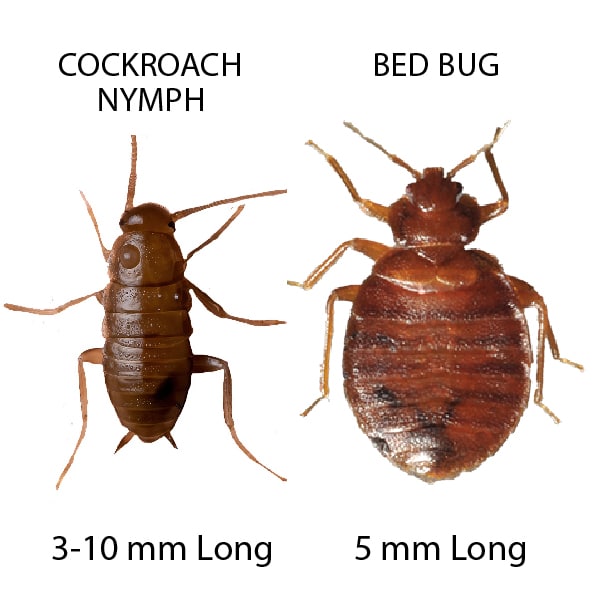
Cockroach Nymph vs Bed Bug
6. Fleas
- Similar Feature: Both fleas and bed bugs are blood feeders.
- Different Feature: Fleas are much smaller, with a laterally compressed body, and can jump long distances.
- Habitat: Commonly found on pets, carpets, bedding, and upholstered furniture.
- Behaviour: Fleas are highly agile and feed on the blood of mammals and birds.
- Bite: Yes

Bed Bug vs Flea
7. Ticks
- Similar Feature: Both ticks and bed bugs feed on blood.
- Different Feature: Ticks have eight legs (bed bugs have six) and are larger when engorged.
- Habita: Found in grassy, wooded areas, often attaching to pets or humans.
- Behaviour: Ticks feed on the blood of mammals, birds, and sometimes reptiles and amphibians, known for transmitting diseases such as Lyme disease.
- Bite: Yes
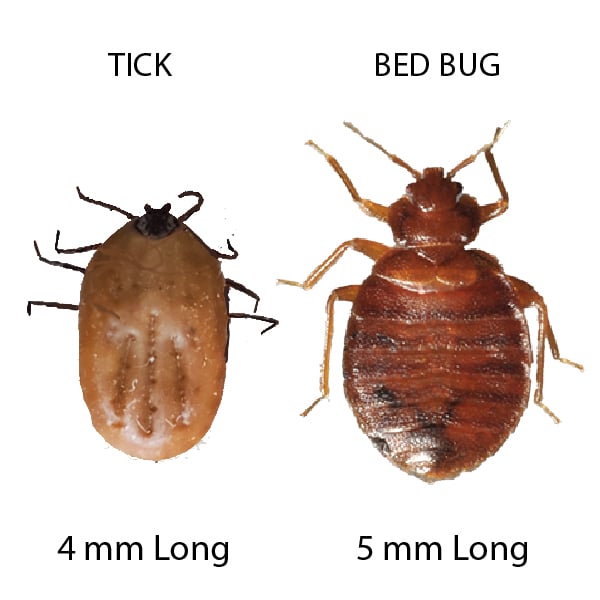
Tick vs Bed Bug
8. Lice
- Similar Feature: Both lice and bed bugs are blood feeders and can cause itching and discomfort.
- Different Feature: Lice are much smaller, with a more elongated body, and live on human hair or clothing.
- Habitat: Found on the human scalp, body, and clothing.
- Behaviour: Lice feed on human blood and cause itching and discomfort.
- Bite: Yes
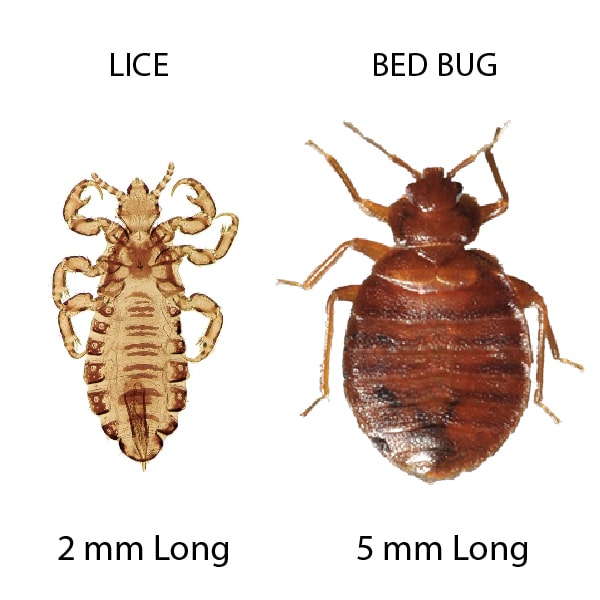
Lice vs Bed Bug
9. Masked Hunter
- Similar Featur: Found in homes where bed bugs are present.
- Different Feature: Much larger, with an elongated body and predatory behaviour (they hunt other insects).
- Habitat: Found in homes, especially where bed bugs are present as they prey on them.
- Behaviour: Masked hunters are predatory bugs that feed on other insects, including bed bugs. They can deliver a painful bite if handled.
- Bite: Yes
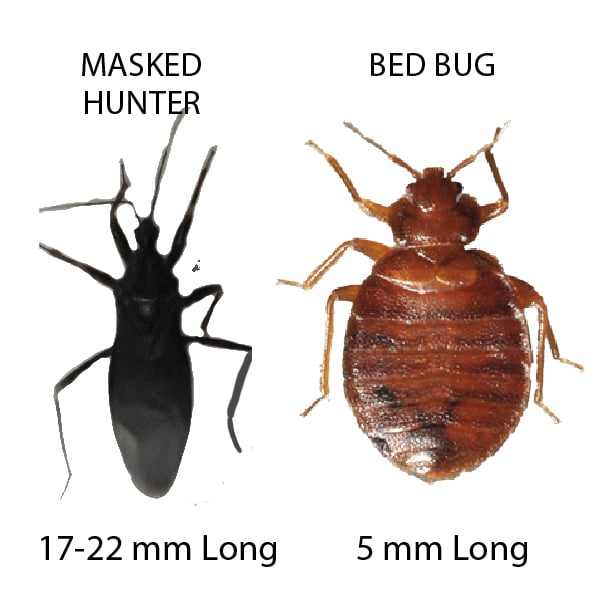
Masked Hunter vs Bed Bug
10. Swallow Bugs
- Similar Feature: Almost identical in appearance to bed bugs.
- Different Feature: Typically found in bird nests and feed primarily on birds.
- Habitat: Found in the nests of swallows and other birds, often in barns, eaves, and other structures where birds roost.
- Behaviour: Swallow bugs primarily feed on the blood of birds but may bite humans if their bird hosts are not available.
- Bite: Yes
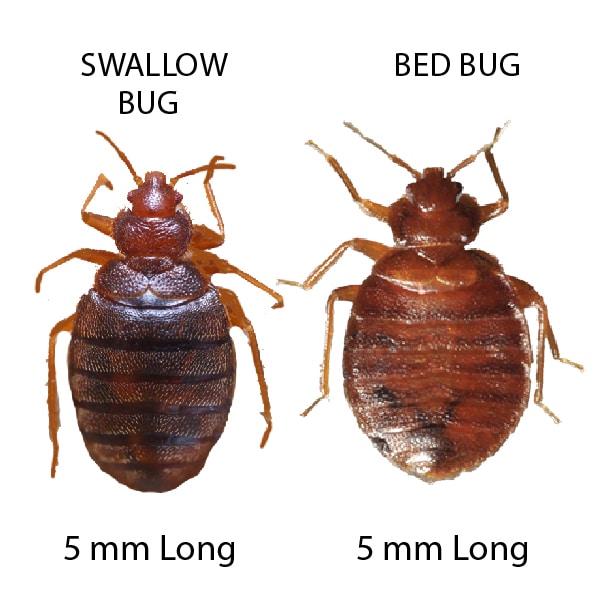
Swallow Bug vs Bed Bug
Conclusion
Accurately identifying bugs that look like bed bugs is crucial for effective control. While many of these bugs share similarities with bed bugs, they also have distinct differences that can help in their identification.
If you suspect an infestation but are unsure of the pest, it may be beneficial to email us to submit a picture for precise identification. Understanding these differences ensures you can take the appropriate steps to address the issue effectively.
Frequently Asked Question:
- What bug can be mistaken for a bed bug?
Bugs that look like bed bugs include bat bugs, which look almost identical to bed bugs but typically live near bat roosts; carpet beetles, whose larvae are often mistaken for bed bugs; spider beetles, which are small and brown like bed bugs; cockroach nymphs, which can resemble bed bugs at first glance; and booklice, tiny insects often found in humid environments that can be confused with bed bug nymphs. - How do you identify a bed bug?
You can identify a bed bug by its size and shape, as they are small, about the size of an apple seed (5-7 mm), and have a flat, oval shape when unfed, becoming more elongated after feeding. Their colour is reddish-brown but becomes more reddish after feeding. Bed bugs have six legs and two antennae, with a three-segmented body consisting of a head, thorax, and abdomen. They are often found in mattresses, bed frames, headboards, and other cracks and crevices near sleeping areas. Additionally, bed bug bites often appear in clusters or lines and cause itching, and other signs include small blood stains on sheets, rusty or dark spots (bed bug excrement), and shed skin. - What are the little brown bugs in my house in Australia?
In Australia, several types of little brown bugs might invade homes. Carpet beetles, often found in carpets, clothing, and furniture; booklice, which thrive in humid environments and are usually found in old books, paper, and damp areas; cockroach nymphs, which are small and brown and often hide in kitchens and bathrooms; spider beetles, small brown bugs commonly found in stored food products; and grain beetles, often found in stored grains and pantry items, can all be potential culprits. Identifying the specific type of bug often requires a close look at their habitat, size, shape, and behaviour.
Are You Looking for an Organic DIY Treatment?
How To Get Rid Of Bed Bugs
Watch Our DIY Treatment Video For An Ensemble Bed
Watch Our DIY Treatment Video For A Bed with Slats
We hope you enjoyed our post about bugs that look like bed bugs. For more information check out our blog page.
Sources:
MDPI (insects), Academic (insect science), Wikipedia (Insect)



Leave a Reply